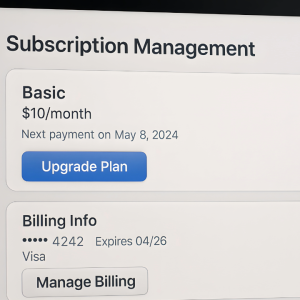The Evolution of Servicing:
The world of servicing has come a long way since its humble beginnings. What was once a manual, paper-based process has transformed into a sleek, technology-driven ecosystem that drives efficiency, accuracy, and enhanced customer satisfaction. As businesses strive for faster and more efficient operations, the evolution of servicing has mirrored the global shift towards digital transformation. In this article, we’ll take a look at how servicing has evolved over the years, the key milestones in this transformation, and the future of servicing in the digital age.
The Traditional Era: Manual Servicing
In the early days of servicing, everything was done manually. Businesses relied heavily on paper documents, physical filing systems, and in-person communication to manage their servicing activities. This process was time-consuming, error-prone, and often led to significant delays. Customer service departments handled everything from billing inquiries to complaints through phone calls or in-person meetings, creating inefficiencies for both the service providers and their clients.
Manual servicing processes often led to a backlog of work, poor communication, and frustration for both customers and staff. As businesses grew and demands increased, it became clear that manual systems couldn’t keep up with the pace of modern operations. The need for change was inevitable.
The Emergence of Digital Solutions
As technology began to evolve in the 1990s, businesses started exploring digital tools to replace traditional methods of servicing. The first wave of digital solutions involved transitioning from paper-based forms to digital documents, with basic database systems replacing filing cabinets. This move helped reduce some of the inefficiencies associated with manual processing and improved accuracy in data entry.
However, it was in the early 2000s that the real shift began. The development of Customer Relationship Management (CRM) software, integrated payment systems, and email communication tools ushered in an era of digital servicing. These early solutions allowed businesses to streamline communication, track customer interactions more effectively, and handle customer queries faster.
While the technology was still in its infancy, these advancements marked the beginning of the digital servicing revolution. Businesses could now automate several aspects of their customer service, improving the overall experience for both clients and employees.
For instance, platforms like Salesforce began offering solutions for tracking customer interactions, enabling businesses to provide better-targeted and more personalized service (source).
The Rise of Automation: AI and Self-Service
By the 2010s, advancements in artificial intelligence (AI) and machine learning began to make waves in the servicing sector. Automated tools such as chatbots and virtual assistants gained popularity, providing instant support to customers and reducing the need for human intervention. AI-powered systems could now handle a variety of tasks—from answering simple customer inquiries to resolving common issues without any human input.
Self-service portals also began to emerge, allowing customers to manage their own accounts, pay bills, schedule appointments, and even troubleshoot problems independently. This shift empowered customers by giving them more control over their service experience and allowed businesses to reduce the strain on their customer service teams.
According to a Forbes article on the future of customer service, AI-driven chatbots are expected to handle up to 75% of customer interactions by 2025, making digital solutions more indispensable than ever before (source).
The Rise of Omnichannel and Data Integration
The 2020s marked a pivotal moment in the evolution of servicing. Businesses began adopting omnichannel servicing platforms that integrated multiple communication channels—such as email, chat, phone, social media, and even text messaging—into a single, cohesive experience. This allowed customers to seamlessly transition between channels while interacting with the business, improving both satisfaction and efficiency.
In addition to omnichannel support, the integration of big data and analytics into servicing platforms allowed businesses to better understand customer needs and predict issues before they arose. By collecting and analyzing vast amounts of data from multiple touchpoints, companies could offer highly personalized services and anticipate customer concerns. For example, predictive analytics tools can flag potential service issues based on historical data, enabling companies to resolve problems proactively.
Platforms like Zendesk and ServiceTitan have been pioneers in this space, offering comprehensive solutions that bring all customer service interactions into one platform, while leveraging data to drive improved service outcomes (source, source).
The Future of Servicing: AI, Automation, and Beyond
As we look ahead to 2025 and beyond, the evolution of servicing will continue to be defined by AI, automation, and digital transformation. Businesses are increasingly relying on advanced technologies like blockchain, machine learning, and predictive analytics to further enhance the customer experience and drive operational efficiencies.
- Blockchain for Transparency: Blockchain technology is beginning to play a role in servicing, particularly in industries like financial services and healthcare, where transparency, security, and accuracy are paramount. Blockchain’s decentralized nature provides a way to securely store and share data, ensuring that both businesses and customers can trust the information being exchanged.
- Voice Assistants and IoT Integration: Voice-activated assistants, powered by AI, will continue to transform customer servicing by enabling hands-free, conversational interactions. Meanwhile, the Internet of Things (IoT) will allow businesses to track products and services in real time, providing customers with updates and even predictive maintenance services based on data gathered from connected devices.
- Enhanced Personalization: With more data at their disposal, businesses will be able to offer hyper-personalized servicing experiences. From tailored recommendations to proactive service interventions, the future of servicing will be customer-centric, relying heavily on data-driven insights to deliver a customized experience.
Servicingpedia: Your Go-To Resource for the Evolution of Servicing
At Servicingpedia, we are committed to providing insights into the ongoing advancements in servicing, helping businesses and professionals stay up to date with the latest trends and technologies. Whether you’re looking to understand how digital transformation is affecting your industry or searching for best practices in customer service automation, Servicingpedia is your trusted source for all things servicing-related.
Explore the evolution of servicing, learn about cutting-edge trends, and discover the future of customer service with Servicingpedia. Start your journey into the future of servicing today!
From manual processes to digital solutions, the servicing industry has come a long way in just a few decades. As technology continues to advance, businesses will need to adapt to stay competitive. Servicingpedia is here to guide you through every step of this transformation, ensuring that you’re equipped with the knowledge and tools to succeed in the ever-evolving world of servicing.






